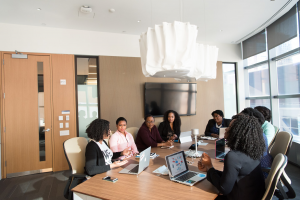“That meeting could’ve easily been an email.”
You’ve probably heard this comment before, and you may have said it yourself a time or two. We live in a time when technology provides us with alternative ways of communicating, so anything that seems unnecessarily time consuming has us rolling our eyes.
When we have options such as email, instant message, telephone, pre-recorded video, two-way video, or in-person meetings, we’re tasked with deciding which is the best fit for the topic at hand. With efficiency in mind, we may opt for whatever form of communication gets our message across in the easiest, quickest way possible. This benefits businesses by expediting messaging that, back in the olden days, used to be limited to mailed letters, telephone calls, or in-person meetings.
But when do these quick avenues of communication begin to work against us? What is the cost of turning nearly all our face-to-face meetings into emails?
We lose collaboration.
One-way communications are just that: one way. When we come face-to-face with colleagues, we can engage in meaningful two-way discussions. When top-down, one-way communication is the norm, employees end up feeling alienated, unmotivated, and like their voices aren’t being heard. This results in lost solutions, lost ideas, and lost innovation—and when these things are lost, overall success is negatively impacted.
Instant messaging doesn’t always suffice for collaboration, either—our message may be lost in a sea of other messages, and the impact of what we’re saying can fall flat. We need a way to express our ideas in a more personal way. When we make time and space for face-to-face communication, we gain much-needed insights from each other, and in doing so, provide opportunity to make a greater positive impact.
We lose our humanity.

By choosing face-to-face communication, we’re giving ourselves a chance to be known and to get to know our colleagues and clients on a deeper, more human, level. For example, Christina@Outlook.com becomes “Chris” for short. She’s the accountant with a contagious laugh, confident smile, foreign accent, and a unique way of getting her point across. We don’t really know Chris until we meet her face-to-face.
We lose clarity.
Emails, text messages, and other non-face-to-face communication can lead to confusion. We lose a sense of the person’s facial expressions, tone and intention. For example, an email you may have interpreted to have an aggressive tone may have had a playful tone if delivered face-to-face. Misunderstandings become commonplace and conflicts become more frequent.
A famous study by Dr. Albert Mehabrian revealed that 93% of the impact of our communication comes from body language, tone, pitch, volume, and rate of speech.
When face-to-face, we receive more information that helps us understand each other more concisely.
Organizations worldwide have undoubtedly felt the impact of the pandemic on how we interact and connect, but remote work doesn’t have to resign us to emails. Thanks to today’s technology, face-to-face meetings don’t have to be in person. With two-way video, you can receive all the same benefits of in-person collaboration without the drawbacks of other virtual communication methods. And best of all, you can skip the traffic and meet face-to-face with anyone, anywhere in the world, from the comfort of your own home or workspace.
When deciding whether a need for communication should be face-to-face, consider the following questions whether you work remotely or in-office:
-
- Would the topic at hand benefit from two-way input? The answer is often yes, especially when big decisions are on the table. Employees want their perspectives considered. If an outcome could potentially shift as the result of collaboration, make it a rule to always include relevant people in the conversation.
- Does the topic at hand relate to individual and/or company-wide goals? Some information—such as a heads up about your building’s upcoming 4th floor construction noise—doesn’t need two-way correspondence. But if the nature of the topic relates to company goals or individual growth, it requires face-to-face conversation. Collaborative goals can’t be achieved unless everyone involved is on the same page and clear about the action items required to get there.
- Does the topic at hand involve important feedback, an interpersonal issue, or a confrontation? It’s tempting to designate the tough conversations to email or instant message but avoiding our anxieties around them can worsen existing problems by inviting misunderstandings. Having tough conversations face-to-face shows respect for the other person by giving them the opportunity to ask questions and get clear on your intentions, and achieving mutual understanding will have the benefit of deepening your connection.
- Is there confusion about the topic at hand? Face-to-face communication can provide an immediate opportunity for clarification. Any time confusion arises, whether it’s within yourself or within a team dynamic, opt right away for face-to-face communication.
It’s true that some meetings would be best suited as an email, but no successful business (or relationship) is exempt from the necessity of face-to-face communication. When we create face-to face opportunities, we gain more collaboration, clarity, and connection.
Luckily, making it happen can be as easy as clicking “join video.”





